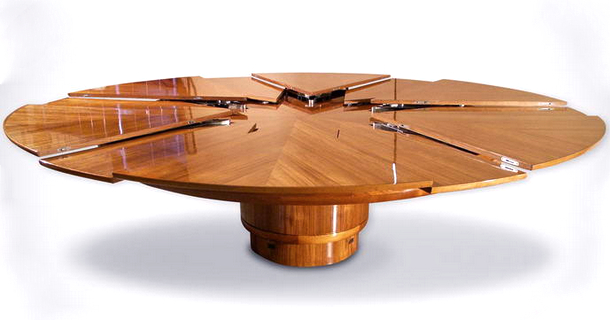

Title: Designer Articulated mechanical expanding table By David Fletcher
Shipping: $29.00
Artist: N/A
Period: Contemporary
History: N/A
Origin: N/A
Condition: Museum Quality
Item Date: New
Item ID: 6550
{Price Upon request} Private sale by owner. Status: Exclusive / Consignment. We Are Art Advisers. Custom sizes and wood colors available. Sophisticated Custom Designer Furniture: Custom furniture for architects, designers, and privet contractors. Our job is to take your designs and make them a reality. Using only the choicest materials. Each piece is all handmade – not mass produced – and may be adapted and adjusted to your color or specifications. Endless possibilities. Fletcher Burwell-Taylor Ltd have created a great solution for when you need extra space at the dinner table – an expanding table. The made to measure round table has folding leaves stored within its body and expands by rotating the surface of the table either manually or with a remote control. The table is suitable for use at home or in harsh saline conditions like on a yacht. * We specialize in high end luxury fine art and collectibles from private estates. - Our job is to find and target great art by collecting a vast array of contemporary, vintage, antique and collectible items from across the globe. Individually handcrafted, we breathe new life into these forgotten relics by giving back each piece it's unique story. We welcome dealers, galleries, and private collectors to register securely and buy with us.
Link: http://en.wikipedia.org/wiki/Table_(furniture)
A table is a form of furniture with a flat horizontal upper surface used to support objects of interest, for storage, show, and/or manipulation. Some common types of table are the dining room table, which is used for seated persons to eat meals; the coffee table, which is a low table used in living rooms to display items or serve refreshments; and the bedside table, which is used to place an alarm clock and a lamp. Another common type of table is a desk, which is typically used to hold items that one would need to do work, such as papers, textbook, or computers. The surface must be held stable. For reasons of simplicity, this is usually done by support from below by either a column, a "base", or at least three columnar "stands". In special situations, table surfaces may be supported from a nearby wall, or suspended from above. Some very early tables were made and used by the Egyptians, and were little more than stone platforms used to keep objects off the floor. They were not used for seating people. Food and drinks were usually put on large plates deposed on a pedestal for eating. The Egyptians made use of various small tables and elevated playing boards. The Chinese also created very early tables in order to pursue the arts of writing and painting. The Greeks and Romans made more frequent use of tables, notably for eating, although Greek tables were pushed under a bed after use. The Greeks invented a piece of furniture very similar to the guéridon. Tables were made of marble or wood and metal (typically bronze or silver alloys), sometimes with richly ornate legs. Later, the larger rectangular tables were made of separate platforms and pillars. The Romans also introduced a large, semicircular table to Italy, the mensa lunata. Furniture during the Middle Ages is not as well known as that of earlier or later periods, and most sources show the types used by the nobility. In the Eastern Roman Empire, tables were made of metal or wood, usually with four feet and frequently linked by x-shaped stretchers. Tables for eating were large and often round or semicircular. A combination of a small round table and a lectern seemed very popular as a writing table. In western Europe, the invasions and internecine wars caused most of the knowledge inherited from the classical era to be lost. As a result of the necessary movability, most tables were simple trestle tables, although small round tables made from joinery reappeared during the 15th century and onward. In the Gothic era, the chest became widespread and was often used as a table. Refectory tables first appeared at least as early as the 17th century, as an advancement of the trestle table; these tables were typically quite long and wide and capable of supporting a sizeable banquet in the great hall or other reception room of a castle.